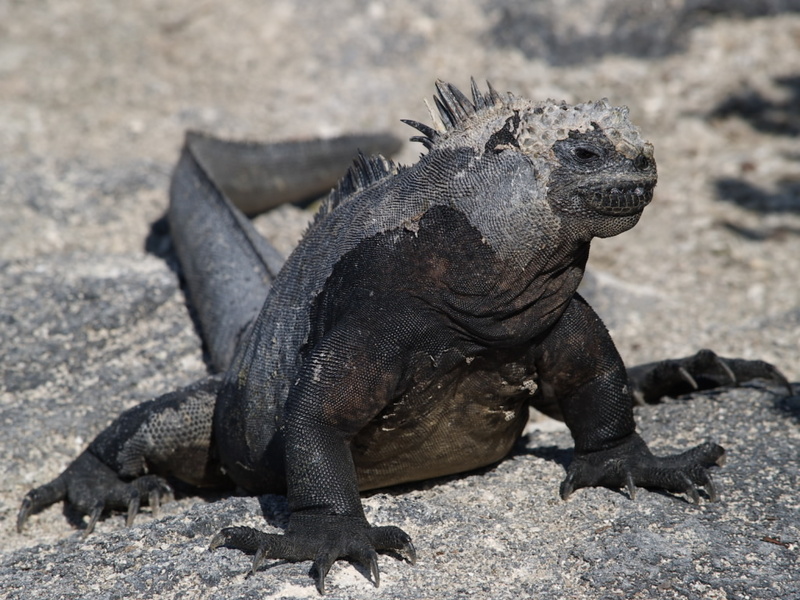| 새로운 사진 | 신문속의 동물소식 | 신기한 동물이야기 | 동물의 소리 | 동물동화상 | 사진 올리기 | 사진 저작권 | English |
|---|
| 재미있는 동물사진 | 괴수/괴어/엽기 동물사진 | 동물이름사전 | 동물목록 | 바깥고리 | 창고입구 | 똑똑누리집 |
|---|
| 이미지 정보 | Original File Name: Marine Iguana (Amblyrhynchus cristatus)03.jpg Resolution: 1024x768 File Size: 321504 Bytes Date: 2004:04:28 16:51:00 Camera: E-1 (OLYMPUS CORPORATION ) F number: f/2.8 Exposure: 1/800 sec Focal Length: 182/1 Upload Time: 2007:09:25 20:07:30 | |
| 올린이 | 이름 (메일주소): Unknown | |
| 사진 제목 | Marine Iguana (Amblyrhynchus cristatus) - Wiki | |
 |
| Email : 카드 | 올린이 | 운영자 사진삭제 정보수정 Admin |
| 설명 | Marine Iguana (Amblyrhynchus cristatus) - Wiki
Marine Iguana
Another difference between the iguanas is size, which is different depending on the island the individual iguana inhabits. The iguanas living on the islands of Fernandina and Isabela (named for the famous rulers of Spain) are the largest found anywhere in the Gal??pagos. On the other end of the spectrum, the smallest iguanas are found on the island on Genovesa. Adult males are approximately 1.3 m long, females 0.6 m, males weigh up to 1.5 kg. Behaviour As a cold blooded animal, the marine iguana can spend only a limited time in the cold sea, where it dives for algae. However, by swimming only in the shallow waters around the island they are able to survive single dives of up to half an hour at depths of more than 15 m. After these dives, they return to their territory to bask in the sun and warm up again. When cold, the iguana is unable to move effectively, making them vulnerable to predation, so they become highly aggressive before heating up (since they are unable to run away they try to bite attackers in this state). During the breeding season, males become highly territorial. The males assemble large groups of females to mate with, and guard them against other male iguanas. However, at other times the species is only aggressive when cold. Marine iguanas have also been found to change their size to adapt to varying food conditions. During El Ni??o conditions when the algae that the iguanas feed on was decreased for a period of two years, some were found to decrease their length by as much as 20%. When food conditions returned to normal, the iguanas returned to their pre-famine size. It is speculated that the bones of the iguanas actually shorten as a shrinkage of connective tissue could only account for a 10% length change. Conservation This species is completely protected under the laws of Ecuador, and is listed under CITES Appendix II. El Ni??o effects cause periodic declines in population, with high mortality, and the marine iguana is threatened by predation by exotic species. The total population size is unknown, but is, according to IUCN, at least 50,000, and estimates from the Charles Darwin Research Station are in the hundreds of thousands. Threats The marine iguanas have not evolved to combat newer predators. Therefore, cats and dogs eat both the young iguanas and dogs will kill adults due to the iguanas' slow reflex times and tameness. Dogs are especially common around human towns and can cause tremendous predation. Cats are also common in towns, but also occur in numbers in remote areas, where they take a toll on iguanas. Evolution Researchers theorize that land and marine iguanas evolved from a common ancestor since arriving on the islands from South America, presumably by driftwood. It is thought that the ancestral species inhabited a part of the volcanic archipelago that is now submerged. A second school of thought holds that the Marine iguana may have evolved from a now extinct family of sea-going reptiles. http://en.wikipedia.org/wiki/Marine_Iguana
| ||
| 저작권 정보 | 사진의 저작권은 원저작자에게 있습니다. 동물그림창고는 동물관련 사진을 전시할 수 있는 공간만을 제공합니다.사진을 사용하고자 할 경우에는 저작권자와 협의하시기 바랍니다. |
|
|
|
| |||||||
| CopyLeft © since 1995, 동물그림창고. All rights may be reserved. | ||||||||
Stats